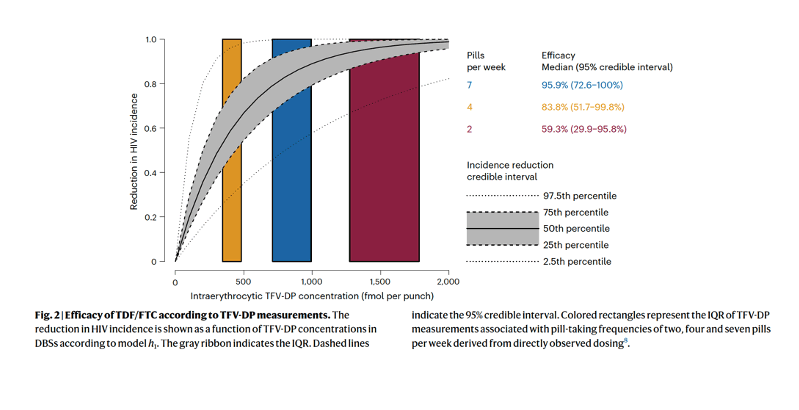| |
Efficacy estimates of oral pre-exposure prophylaxis
for HIV prevention in cisgender women with partial adherence
|
| |
| |
Download the PDF here
Nature Medicine Oct 2023
Two modelling studies offer compelling evidence that less-than-perfect adherence to HIV pre-exposure prophylaxis can still provide reasonable protection for cisgender women - providing optimism for a more person-centered approach and lower discontinuation rates. Here is one....
Abstract
Pre-exposure prophylaxis (PrEP) with tenofovir (TFV) disoproxil fumarate and emtricitabine administered orally daily is effective in preventing human immunodeficiency virus (HIV) acquisition in both men and women with sufficient adherence; however, the adherence-efficacy relationship in cisgender women has not been well established. We calculated the adherence-efficacy curve for cisgender women by using HIV incidence and plasma TFV concentration data from three trials (FEM-PrEP, VOICE and Partners PrEP). We imputed TFV diphosphate (TFV-DP) concentrations, a measure of long-term adherence, from TFV quantification by using data from the HIV Prevention Trials Network 082 study, which measured both TFV-DP and TFV concentrations. Two, four and seven pills per week reduced HIV incidence by 59.3% (95% credible interval (CrI) 29.9-95.8%), 83.8% (95% CI 51.7-99.8%) and 95.9% (95% CI 72.6-100%), respectively. Our adherence-efficacy curve can be validated and updated by HIV prevention studies that directly measure TFV-DP concentrations. The curve suggests that high adherence confers high protection in cisgender women. However, the lower efficacy with partial adherence highlights the need for new PrEP products and interventions to increase adherence.
We estimated that women with TFV-DP concentrations associated with pill-taking frequencies of two, four and seven pills per week had 59%, 84% and 96% lower HIV incidence, respectively, than those not taking PrEP. These reductions are only slightly lower than those estimated in MSM/TGW at the same levels of adherence7,9, suggesting that the lower observed efficacy in PrEP trials in women is primarily due to adherence. This is consistent with subgroup analyses in Partners PrEP and HPTN 084 that found high effectiveness in women with quantifiable plasma TFV and TFV-DP concentrations consistent with taking two or more pills per week11,12, as well as with a recent meta-analysis that found high levels of protection in women consistently taking four to six pills per week in PrEP demonstration projects24.

|
|
| |
| |
|
|
|